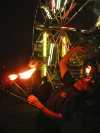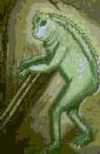 The use of the fork is a basic concern of Western table etiquette. The utensil’s origin is disputed; certain passages in the book of I Samuel suggest that forks were used during priestly sacrifice, and it is commonly accepted that the Greeks used serving forks long before the Middle Ages. Before the fork made its 10th century debut at tables across Europe, people commonly used their hands to eat. Why did the Roman Catholic Church initially consider the use of a fork an insult to God? Discuss
The use of the fork is a basic concern of Western table etiquette. The utensil’s origin is disputed; certain passages in the book of I Samuel suggest that forks were used during priestly sacrifice, and it is commonly accepted that the Greeks used serving forks long before the Middle Ages. Before the fork made its 10th century debut at tables across Europe, people commonly used their hands to eat. Why did the Roman Catholic Church initially consider the use of a fork an insult to God? Discuss
Source: The Free Dictionary
 Music existed long before human cultures were literate or had developed a written system of record-keeping, perhaps originating as an attempt to echo the sounds and rhythms of nature. These sounds may have been used to lure prey while hunting or in recreational or shamanistic rituals. The oldest known bone flute is about 50,000 years old, but experts believe that humans may have used what to create a form of music that predates such instruments?
Music existed long before human cultures were literate or had developed a written system of record-keeping, perhaps originating as an attempt to echo the sounds and rhythms of nature. These sounds may have been used to lure prey while hunting or in recreational or shamanistic rituals. The oldest known bone flute is about 50,000 years old, but experts believe that humans may have used what to create a form of music that predates such instruments?  Fire-eaters are entertainers who extinguish flaming objects and transfer flames using their mouths and other body parts. The tradition of fire-eating was embedded in the spiritual performances of Hindu ascetics, and by the late 1880s, these daring acts had become a standard element in sideshow productions. Extinguishing tricks are the traditional hallmark of fire-eating, and performers often use their mouths to snuff out 1, 2, or even 3 flaming torches. What is the “secret” to fire-eating?
Fire-eaters are entertainers who extinguish flaming objects and transfer flames using their mouths and other body parts. The tradition of fire-eating was embedded in the spiritual performances of Hindu ascetics, and by the late 1880s, these daring acts had become a standard element in sideshow productions. Extinguishing tricks are the traditional hallmark of fire-eating, and performers often use their mouths to snuff out 1, 2, or even 3 flaming torches. What is the “secret” to fire-eating?  While the 1970 Bhola cyclone was not the strongest tropical cyclone to hit East Pakistan (now Bangladesh), it was the deadliest, claiming approximately half a million lives. It ranks among the most deadly natural disasters of modern times. The low-lying islands of the Ganges Delta were particularly susceptible to the storm surge’s floodwaters, which reached 33 ft (10 m) when the cyclone made landfall. How did this tragic event help to bring about the establishment of Bangladesh?
While the 1970 Bhola cyclone was not the strongest tropical cyclone to hit East Pakistan (now Bangladesh), it was the deadliest, claiming approximately half a million lives. It ranks among the most deadly natural disasters of modern times. The low-lying islands of the Ganges Delta were particularly susceptible to the storm surge’s floodwaters, which reached 33 ft (10 m) when the cyclone made landfall. How did this tragic event help to bring about the establishment of Bangladesh?  A zombie computer, or zombie, is a computer attached to the Internet that has been compromised by a hacker, computer virus, or trojan horse. Generally, a compromised machine is only one of many in a network of remotely controlled computers used to perform malicious tasks. Most owners of zombie computers are unaware that their systems are being used in this way, but the damage caused by such systems can be devastating. Approximately what percent of the world’s spam is sent from zombie computers?
A zombie computer, or zombie, is a computer attached to the Internet that has been compromised by a hacker, computer virus, or trojan horse. Generally, a compromised machine is only one of many in a network of remotely controlled computers used to perform malicious tasks. Most owners of zombie computers are unaware that their systems are being used in this way, but the damage caused by such systems can be devastating. Approximately what percent of the world’s spam is sent from zombie computers? .jpg) The ritualistic killing of children was a common religious practice in some of the prominent pre-Colombian cultures. The Olmec civilization, which flourished in the tropical lowlands of south-central Mexico between 1200 and 400 BCE, may have been one such society. Evidence of the brutal practice was found in the El Manatí sacrificial bog, where the skeletons of an unknown number of infants were uncovered. How many times a year did the Aztecs celebrate religious festivals with child sacrifice?
The ritualistic killing of children was a common religious practice in some of the prominent pre-Colombian cultures. The Olmec civilization, which flourished in the tropical lowlands of south-central Mexico between 1200 and 400 BCE, may have been one such society. Evidence of the brutal practice was found in the El Manatí sacrificial bog, where the skeletons of an unknown number of infants were uncovered. How many times a year did the Aztecs celebrate religious festivals with child sacrifice?  The candirú is a parasitic freshwater catfish typically found in the Amazon River. The translucent, eel-shaped “toothpick fish” is reputed to be the most feared fish in the river and earned this distinction because of its proclivity for attacking and entering the human body via any available orifice, especially the urethra. The creature has protruding spines which make it nearly impossible to remove from the body without surgical intervention. How does the fish locate its human host?
The candirú is a parasitic freshwater catfish typically found in the Amazon River. The translucent, eel-shaped “toothpick fish” is reputed to be the most feared fish in the river and earned this distinction because of its proclivity for attacking and entering the human body via any available orifice, especially the urethra. The creature has protruding spines which make it nearly impossible to remove from the body without surgical intervention. How does the fish locate its human host?  Biologically speaking, senescence is the process of deterioration that follows the development of an organism. In 1965, Leonard Hayflick discovered that normal diploid cells divide in cell culture about 50 times before entering a senescence phase during which they can replicate no more. Each cell division shortens the telomere of the cell’s DNA, thus ticking back an “inner clock” for each subsequent copy of the cell. How does this mechanism protect the body from disease?
Biologically speaking, senescence is the process of deterioration that follows the development of an organism. In 1965, Leonard Hayflick discovered that normal diploid cells divide in cell culture about 50 times before entering a senescence phase during which they can replicate no more. Each cell division shortens the telomere of the cell’s DNA, thus ticking back an “inner clock” for each subsequent copy of the cell. How does this mechanism protect the body from disease?  In 1955, a businessman reported seeing a frog-faced humanlike creature under a bridge in Loveland, Ohio. Nearly 20 years later, local police reportedly sighted the elusive creature, dubbed the Loveland Frog, and unsuccessfully attempted to shoot it. One of the officers allegedly described the creature as standing 3 to 4 feet tall, weighing between 50 to 75 pounds, having leathery skin, a frog- or lizard-like face, and, possibly, a tail. What are some explanations for these sightings?
In 1955, a businessman reported seeing a frog-faced humanlike creature under a bridge in Loveland, Ohio. Nearly 20 years later, local police reportedly sighted the elusive creature, dubbed the Loveland Frog, and unsuccessfully attempted to shoot it. One of the officers allegedly described the creature as standing 3 to 4 feet tall, weighing between 50 to 75 pounds, having leathery skin, a frog- or lizard-like face, and, possibly, a tail. What are some explanations for these sightings?